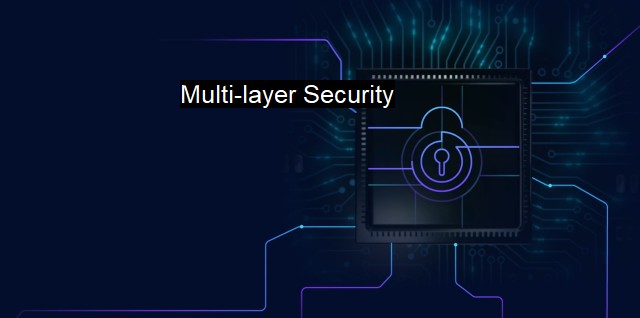What is Multi-layer Security?
Protecting Your Business from Cyber Threats: The Power of Multi-Layer Security in Today's Digital World
Multi-layer security, often referenced in the universe of cybersecurity and antivirus, is a holistic and strategic approach to security that incorporates multiple defenses working together to protect a computer or network. Instead of relying on a single security measure, this approach strategically employs several measures to resist cyber threats from different angles and mitigate potential damage.The understanding of multi-layer security begins with the interpretation of its reference to 'layers'. these layers are denominated as controls or protective measures to prohibit unauthorized access to networks or databases. Acceptably, the more layers of security a system possesses, the harder it will be for cybercriminals to breach the system effectively.
Technically, multi-layer security operates at different levels starting from the outermost perimeters to the core. It can look into the network's wide area network (WAN), securing the local area network (LAN), antivirus protection, firewall configuration, user access controls, web filtering, email security, data encryption, intrusion detection systems (IDS), and intrusion prevention system (IPS), amongst others.
A critical cornerstone of these layers of security is the firewall. It provides a suitable barrier between the trusted internal network and the untrusted outside network. It closely follows the rules specified by a user or system administrator to decide which traffic is allowed and which is not.
Next, antivirus protection takes defensive action to identify and eliminate any malicious software trying to invade the operating system. Most antivirus software offers real-time protection, which enables immediate detection and removal of any malicious program or file.
Email security should also be prioritized due to the prevalence of phishing attacks initiated via email. A secure email system is empowering to detect and destroy spam, avert phishing scams, block inappropriate content, and prevent data loss through inbound and outbound email.
Web filtering denotes another crucial layer of a multi-layer security approach. The tool allows system administrators to limit specific websites that may pose potential threats to the network. Undoubtedly, such restrictions reduce exposure to harmful software.
Multi-layer security underscores the importance of data encryption as it converts information into ciphertext, rendering it unreadable to an unauthorized person. When the data is transferred over the network, even if a hacker intercepted it, they could not make sense of the contents without the proper decryption key.
Intrusion detection and prevention systems are devoted to identifying and responding to anomalous or suspicious behavior. They provide an extra defense layer by recognizing whether an uncommon action fits within the context of a cyber-attack, followed by executing the appropriate response.
While multi-layer security offers a promising stance, its optimal functionality lies within these structures' ability to communicate and integrate one another seamlessly. They must work harmoniously as one unit in their shared aim of anticipating, preventing, or mitigating threats.
To materially summarize, multi-layer security is about the synergistic application of varied processes, tools, and philosophies, each dealing with a different threat or vulnerability type. Its systemic approach covers the protection perimeter, blocking potential vulnerabilities and minimizing the exposure surface to a possible cyberattack. Hence, businesses and entities seeking to fortify their digital fortress should prioritize strategies that involve deploying multiple layers of security controls and measures. Nonetheless, they should remember that multi-layer security is not a guarantee of complete eradication of cyber threats or attacks, but a strength-in-depth approach considerably reducing the likelihood of successful hack attempts.

Multi-layer Security FAQs
What is multi-layer security?
Multi-layer security is a cybersecurity approach that involves using multiple layers of defenses to protect a system or network against various cyber threats. This approach aims to provide comprehensive protection by combining several security measures such as firewalls, antivirus software, intrusion detection systems, and encryption technologies.Why is multi-layer security important?
Multi-layer security is essential because it reduces the risk of cyber attacks and enhances the overall security of a system or network. The different layers of security work together to provide a more robust defense against various threats, making it more challenging for cybercriminals to penetrate and compromise a system.What are the benefits of using multi-layer security?
The benefits of using multi-layer security include increased protection against cyber threats, reduced risk of data breaches, and improved resilience in the face of attacks. By using multiple layers of security, businesses and organizations can detect and respond to cyber threats more effectively, minimizing the damage caused by a potential attack.What are some examples of multi-layer security measures?
Some examples of multi-layer security measures include firewalls, intrusion detection/prevention systems, antivirus software, spam filters, VPNs, encryption technologies, and two-factor authentication. These security measures provide different types of protection and work together to create a comprehensive defense against cyber attacks.| | A | | | B | | | C | | | D | | | E | | | F | | | G | | | H | | | I | | | J | | | K | | | L | | | M | |
| | N | | | O | | | P | | | Q | | | R | | | S | | | T | | | U | | | V | | | W | | | X | | | Y | | | Z | |
| | 1 | | | 2 | | | 3 | | | 4 | | | 7 | | | 8 | | |||||||